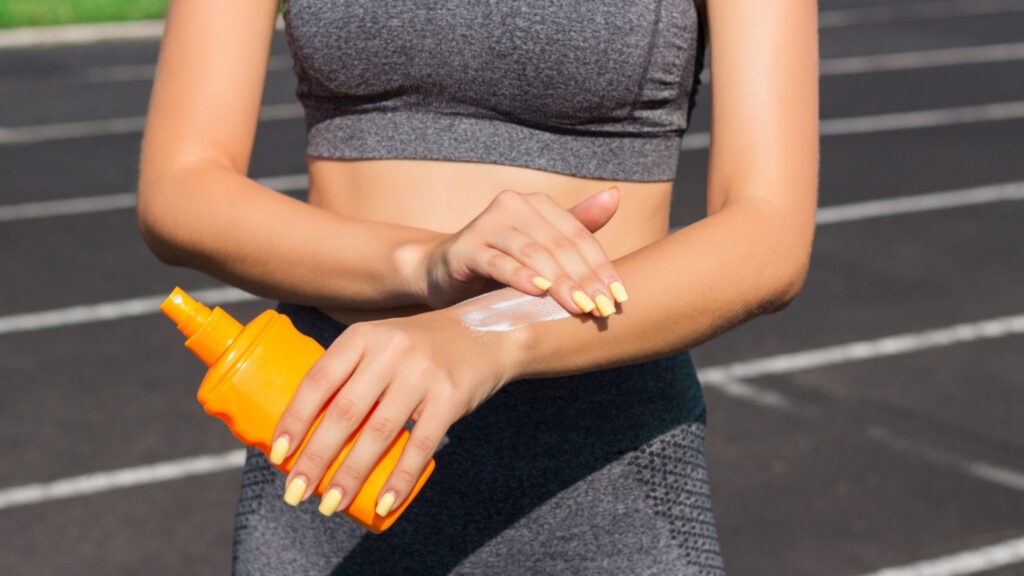When choosing sunscreen, there are three primary things to consider:
- Broad spectrum protection (UVA/UVB)
- Sun Protection Factor (SPF)
- Water resistance
Broad spectrum protection (UVA/UVB)
Look for the words “broad spectrum” on the label, which means the sunscreen protects you from both Ultraviolet A (UVA) and Ultraviolet B (UVB) rays, which are both proven to damage the skin.1
- UVA rays are the sun’s solar wavelengths that penetrate the skin more deeply, and can contribute to premature aging of the skin (e.g., wrinkles, sagging, skin spots, leathery skin).1,2,3
- UVB rays damage the upper surface of the skin, and are the sun’s solar wavelengths that are the main cause of sunburn.1
- Both UVA and UVB rays can damage the skin’s DNA to the point that genetic mutations occur and can lead to skin cancer .1,4
Sun Protection Factor (SPF)
Both the American Academy of Dermatology and the American Cancer Society recommend choosing a sunscreen with a sun protection factor (SPF) value of 30 or higher.2,5
“All sunscreens are tested to measure the amount of UV radiation exposure it takes to cause sunburn when using a sunscreen compared to how much UV exposure it takes to cause a sunburn when not using a sunscreen. The product is then labeled with the appropriate SPF value.”6 While this testing is related to UVB radiation, thanks to FDA regulations, any product labeled broad spectrum is required to have equal UVA protection as well.4
Facts and Myths about SPF Values
Still, there are a few misconceptions related to SPF values. Here’s a quick look at the myths and facts:
- Myth #1: If I normally sunburn in one hour without sunscreen, then wearing a sunscreen with SPF 15 will allow me to stay in the sun for 15 hours or 15 times longer.
- Fact: The SPF is not related to the time, but rather to the amount of solar exposure; and the amount of solar exposure can vary depending on the time of day, as well as your geographic location. For example, the sun is strongest in the middle of day compared to early morning or early evening. There is also greater solar intensity if you live in lower latitudes versus higher latitudes.6,7
- Myth #2: A higher number SPF will allow me to stay in the sun a longer amount of time without reapplication.
- Fact: Higher SPF values last the same amount of time as lower SPF values. All sunscreens need to be reapplied every 2 hours when outdoors.1 High numbered SPFs do mean more protection from UV radiation, but only incrementally with SPF 15 filtering out about 93% of UV rays, while SPF 30, 50, and 100 filter out about 97%, 98%, and 99%, respectively.5 No sunscreen filters out all UV radiation.
Water resistance
Look for a sunscreen labeled water-resistant or very water-resistant.
- A water-resistant sunscreen should protect you for 40 minutes while in the water or on wet skin (sweaty) before needing reapplication.8
- A very water-resistant sunscreen should protect you for 80 minutes while in the water or on wet skin (sweaty) before needing reapplication.8
- If your skin remains dry while using a water-resistant sunscreen, you’ll still need to reapply every 2 hours.
- There is no such thing as a waterproof sunscreen. Additionally, words like sport on sunscreens, while often used on water-resistant products, are not regulated. So, be sure to read the label for water-resistance when participating in outdoor sports.8
Other Considerations
When choosing sunscreen, consider when, where, how much, and which type of sunscreen to apply for your needs, as well as what to avoid.
When
- Sunscreen should be applied 15 minutes before going outside to allow it time to fully absorb and protect your skin.
- Sunscreen should also be applied in all seasons because the sun’s rays can bounce off and reflect damaging UV rays from snow, water, and sand.9 It can also penetrate clouds, fog, and windows. So, be sure to apply sunscreen even if you can’t see the sun, and for long car rides if you don’t have filters on your window glass. “Sun exposure inside a car is equivalent to being outside.”10 You can also consider applying a transparent window film to your car’s windows to block UVA and UVB rays.10
Where
- Be sure to apply on all exposed skin.11 Don’t forget the neck, face, ears, top of the feet and hands.
- Apply a lip balm of at least SPF 15.
- Have someone rub sunscreen into your back or use a spray sunscreen for those hard-to-reach places.
- If you are bald or have thinning hair, be sure to apply sunscreen to your scalp or wear a wide-brimmed hat.11
How much
- Be sure to use enough sunscreen to cover all areas of exposed skin. For adults, that’s about 1 ounce, which is roughly 2 tablespoons, or the amount that fits in the palm of your hand. (The amount that would fit in a shot glass is another good visual equal to about 1 ounce of sunscreen.)
Which type
- Sunscreens come in many forms – creams, lotions, sprays, gels, and sticks. The American Academy of Dermatology suggests:
- Creams for dry skin;
- Gels for hairy areas like the scalp or male chest;
- Sticks for around the eyes;
- Sprays for parents that prefer easy application on children. (Note: Be sure to use enough to thoroughly cover all exposed skin. Also, always spray sunscreen into your hands before rubbing onto your child’s face.)9
- Sunscreens also come in combination with moisturizers and cosmetics. Just remember, they will still need to be reapplied.
What to avoid
- Infants: Do not use sunscreen on infants younger than 6 months old. It’s best to keep them in the shade, and dress them in long-sleeved shirts, pants, wide brimmed hats, and sunglasses.8
- Insect repellants: Avoid sunscreens combined with insect repellants. Sunscreen needs to be reapplied liberally and often, while insect repellant should be applied sparingly and less often.8
- Expiration: Be sure your sunscreen has not expired. Sunscreen can last up to 3 years. Check the expiration date. “A sunscreen product that doesn’t have an expiration date should be considered expired 3 years after purchase. Expired sunscreens should be discarded because there is no assurance that they remain safe and fully effective.”6 If there is no expiration date, and you don’t know when the sunscreen was purchased, throw it out. Also, if you see obvious changes in the color or consistency of the sunscreen product, it’s time to buy a new bottle.
“Sun exposure is cumulative…. Everything from your childhood through present day contributes to your risk for skin cancer. Practicing sun protection and making it a habit is key.”10 So, go ahead – get outside – go for a walk, or go out and play, just don’t forget the sunscreen.
Infographic
Download the PDF or share the image below to help others learn how to choose sunscreen.
- Skin Cancer Foundation. How to read a sunscreen label. July 5, 2022. Accessed June 9, 2023. https://www.skincancer.org/blog/how-to-read-a-sunscreen-label/.
- American Academy of Dermatology. How do I know if I’m using the right sunscreen? April 14, 2022. Accessed June 9, 2023. https://www.aad.org/public/everyday-care/sun-protection/shade-clothing-sunscreen/choosing-right-sunscreen.
- S. Food and Drug Administration. Facts about sunscreen. May 16, 2023. Accessed May 30, 2023. https://www.fda.gov/news-events/rumor-control/facts-about-sunscreen.
- Venosa A. Breaking down broad-spectrum protection: Why your sunscreen needs to have it. The Skin Cancer Foundation. June 28, 2018. Accessed May 31, 2023. https://www.skincancer.org/blog/broad-spectrum-protection-sunscreen/.
- Simon, S. Choose the right sunscreen. American Cancer Society. Accessed May 30, 2023. https://www.cancer.org/cancer/latest-news/choose-the-right-sunscreen.html
- S. Food and Drug Administration. How to help protect your skin from the sun. U.S. Food and Drug Administration. Accessed May 31, 2023. https://www.fda.gov/drugs/understanding-over-counter-medicines/sunscreen-how-help-protect-your-skin-sun.
- com. Regarding latitude: High vs middle vs low. Accessed June 1, 2023. https://spaceweather.com/glossary/latitudes.html.
- American Academy of Dermatology. How to decode sunscreen labels. Accessed June 5, 2023. https://www.aad.org/public/everyday-care/sun-protection/shade-clothing-sunscreen/understand-sunscreen-labels.
- American Academy of Dermatology. Sunscreen FAQs. Accessed June 5, 2023. https://www.aad.org/public/everyday-care/sun-protection/shade-clothing-sunscreen/sunscreen-faqs.
- Northwestern Medicine. Safe on the Sunny Side. Northwestern Medicine. May 2022. Accessed June 12, 2023. https://www.nm.org/healthbeat/healthy-tips/guide-to-skin-protection.
- American Academy of Dermatology. How to apply sunscreen. May 30, 2023. https://www.aad.org/public/everyday-care/sun-protection/shade-clothing-sunscreen/how-to-apply-sunscreen.





